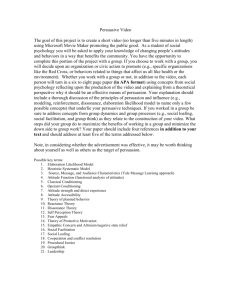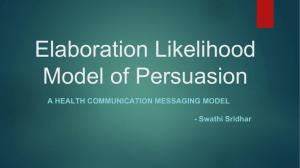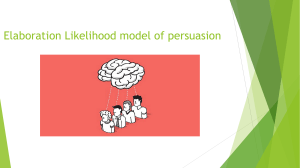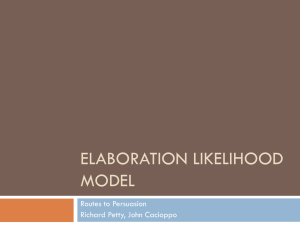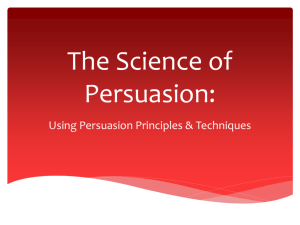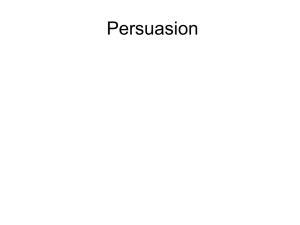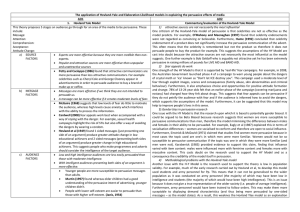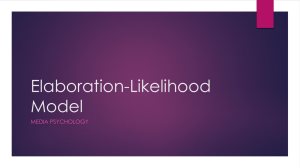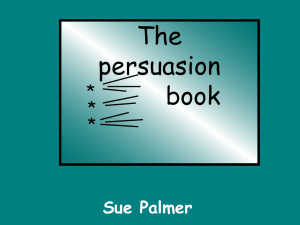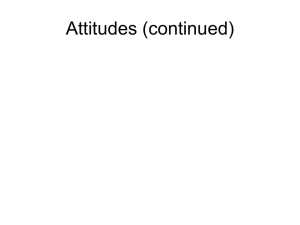Persuasion
advertisement
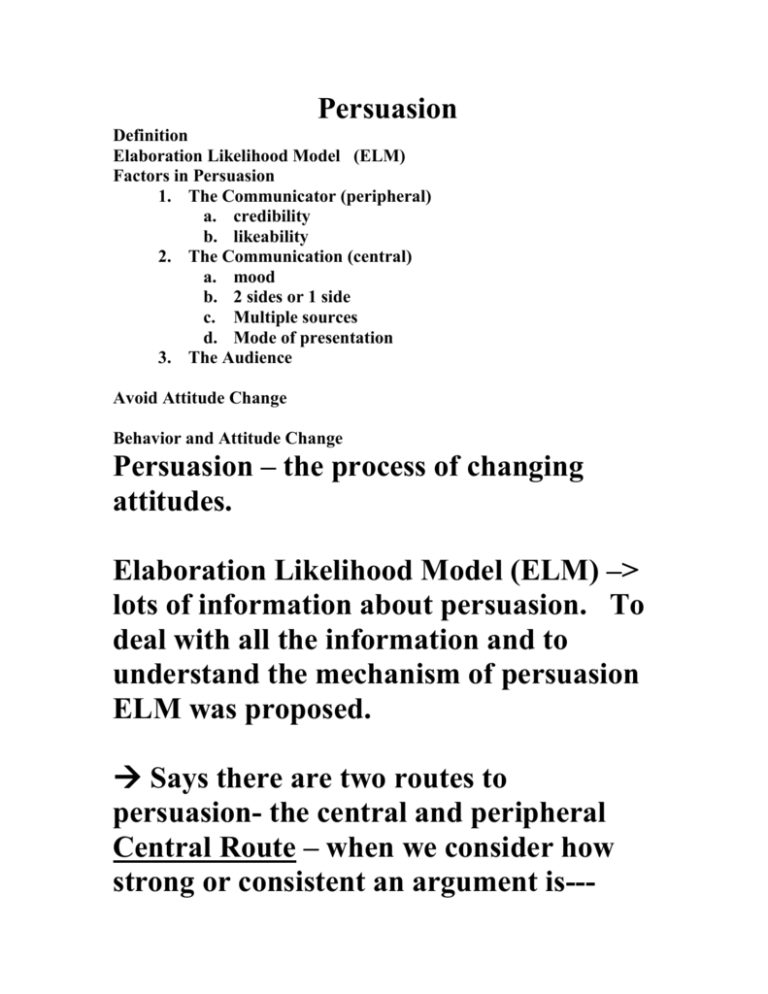
Persuasion Definition Elaboration Likelihood Model (ELM) Factors in Persuasion 1. The Communicator (peripheral) a. credibility b. likeability 2. The Communication (central) a. mood b. 2 sides or 1 side c. Multiple sources d. Mode of presentation 3. The Audience Avoid Attitude Change Behavior and Attitude Change Persuasion – the process of changing attitudes. Elaboration Likelihood Model (ELM) –> lots of information about persuasion. To deal with all the information and to understand the mechanism of persuasion ELM was proposed. Says there are two routes to persuasion- the central and peripheral Central Route – when we consider how strong or consistent an argument is--- scrutinize a message to see if it is persuasive. Peripheral route -- not message content that persuades but other factors such as mood, personal characteristics like expertise, likeability, similarity etc… nothing to do with the argument or message. Elaboration – used to refer to the scrutiny with which a person examines a message content – important to know which conditions will cause elaboration….more scrutiny = more persuasion The Communicator ----peripheral route persuasion----1. Credibility – a source is more effective at persuading if perceived as credible. Source is more credible if a. Competent b. Trustworthy competence – refers to speaker’s ability….knowledgeable, smart, well spoken, credentialed trustworthy – willing to report what they know truthfully---trust established by speakers who are not purposefully trying to change our views….nothing to personally gain. 2. Likeability --- the more likable a person is the more persuasion accomplished through the peripheral route……people are likeable b/c 1. similarity 2. physical beauty. The Communication – central route ---Persuasion can only occur on the basis of the communication if the target is motivated to use the central route…(elaboration)...personal involvement and importance are reason for using the central route. Mood – A message is more persuasive if the audience is in a positive mood. ---feeling bad –common to use fear to try and persuade.-attitude change will follow a fear-arousing communication only if people know what to do to reduce their fear……… Two-sided arguments?— should you present one side of an argument or both? .....one-sided communications are more convincing, but, people who realize that there is a second side may feel freedom is threatened and react negatively. Onesided arguments best only if the audience doesn’t realize there is another side. Multiple Sources – info presented by multiple sources tends to get greater scrutiny than the same info presented by single source. ----when info is strong, increasing the number of sources tends to increase favorable issue-relevant thinking (more agreement) than when weak. ----multiple sources increase the likelihood of processing the message via the central route, so argument has to be strong. Mode of presentation -- tv versus print media……..when the message is complex, print is better than tv-+ ---when the message is simple the tv produces more attitude change Audience Don’t want to say the same thing to everyone….Important to tailor message to attitudes of audience…..not too extreme so arguments are rejected When people hear a communication they either assimilate or contrast the message to what is already known. …..if they feel strongly about an issue they will find fewer positions other then their own to be acceptable and unacceptable opinions will be distorted. 1. Assimilation –opinions that are acceptable are made to appear more similar to their own position than they really are. 2. Contrast – unacceptable opinions are made to appear more extreme than they really are (contrast). The most persuasive arguments will be one that is not so extreme for the audience that it “contrasts” rather than “assimilates” it. Avoiding Attitude Change 1. Forewarning--- advance knowledge that we are to get a persuasive message leads to less attitude chance…..forewarning gives audience time to collect their thoughts and come up with counter-arguments. 2. Selective avoidance tendency to direct attention away from info that challenges our existing attitudes. 3. Inoculation hearing counterargument against our position inoculates these attitudes from change----those in which there are fewer counter-arguments more likely to be changed……
